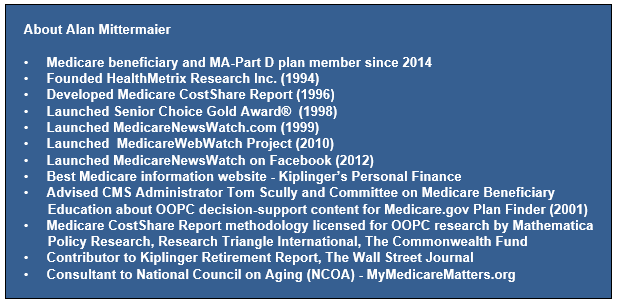Why Medicare Advantage Plans Should Super-Size Baseline Prevention Screenings
April 1, 2022
How can Medicare Advantage plan executives leverage supplemental benefits to empower their current and prospective members to take more control of their health while boosting member satisfaction and Star ratings? HealthMetrix Research president Alan Mittermaier, a Medicare PPO member and Medicare thought leader, weighs in on expanding the scope of baseline prevention screening measures beyond the current CMS “Welcome to Medicare” preventive visit and annual “Wellness” visit recommendations.
CMS-Recommended Baseline Prevention Screenings Remain Limited in Scope
As a relatively healthy and well-informed 72 year old Medicare Advantage plan member, I like to believe I have a good grasp about managing my health as I age. Despite following my PCP’s guidance since my “Welcome to Medicare” visit (2014) and subsequent annual “Wellness” visits, I realize I can only manage what I know about key personal health performance measures. During my recent annual “Wellness” visit, I inquired about arranging an echocardiogram (cardiac ultrasound) in order to establish a baseline for my heart’s pumping output (% ejection refraction). Given that I do not have a history of heart disease nor a family history of heart failure, my PCP informed me that my testing profile (normal EKG, blood pressure, cholesterol and triglycerides results) does not justify ordering a baseline echocardiogram.
Upon researching fees for a non-insured standard echocardiogram procedure, the minimum sticker price would approach $1,000+ interpretation fee. Does a $1,000+ out-of-pocket cost represent a value proposition beyond simply ‘peace-of-mind’ assurance about my heart health? In my case YES, I want to know exactly how well my most important body organ is performing both now (baseline) and for future comparison over the next two, five, ten years ahead. For many beneficiaries, however, a $1,000+ out-of-pocket cost is a reach they cannot afford.
There are other often ‘silent’ health issues that deserve to be considered by CMS as baseline prevention screenings offered during everyone’s “Welcome to Medicare” visit. Unlike a standard echocardiogram, other screenings are not as cost-prohibitive yet would provide beneficiaries and their providers with a comprehensive baseline snapshot of their health status for future comparison. Examples include --
- Abdominal aortic aneurysm ultrasound screening;
- Bone density/osteoporosis ultrasound screening for males (currently routine for females only);
- Carotid artery/stroke ultrasound screening.
Can Medicare Advantage Plans Gain a Competitive Advantage by Super-Sizing Baseline Prevention Screenings?
Absolutely, especially if boosting member satisfaction and Star ratings are the ROI key considerations! There is ample reason to believe that plans will realize a competitive advantage if they adopt additional baseline prevention screenings beyond the current CMS recommended screenings. Super-sizing baseline prevention screenings is all about supporting a member-centric point-of-view model embracing these observations --
- Older adults continue to be on ‘high alert’ about post-pandemic health concerns, especially those experiencing stress due to COVID ‘long haul’ issues or vaccination side effects. Additional prevention screenings can provide assurance and ‘peace-of-mind’ by either ruling out ‘silent’ health issues or discovering such health issues at early stages for follow up.
- Informed beneficiaries with friends and relatives who are heart disease or stroke survivors will likely be receptive to undergoing baseline prevention screenings for themselves when screenings are promoted as ‘real life difference-makers’.
- Thrift-minded beneficiaries will view new baseline prevention screenings as value-added services with little or no additional out-of-pocket cost, especially important for those on fixed incomes and pinched by the 15% Part B premium increase and consumer goods inflation pressures.
- Availability of additional baseline prevention screenings will help promote member awareness about ‘silent’ health issues and the screening options that may be overlooked by their PCP.
- Retired and semi-retired beneficiaries typically have the free time available to schedule baseline screenings when it is most convenient for them. The time commitment for most screenings is minimal (15-20 minutes) with no fasting or other prep required.
Baseline Prevention Screening Super-Sizing Challenge
If asked to offer advice to Medicare Advantage executive leadership, it would be to seize the opportunity and explore strategies for super-sizing baseline prevention screening in partnership with traditional network providers (PCPs, clinics) and mobile screening vendors (e.g., DocGo, Life Line Screening*). Assume that CMS is only likely to expand the scope of the “Welcome to Medicare” routine screenings (last done in 2016) with positive cost-benefit evidence. Until that occurs, Medicare Advantage plans can serve as the ‘canary in the coal mine’ by generating real life cost-benefit justification to super-size baseline prevention screenings for all Medicare beneficiaries.
[* Personal note: Thanks to Life Line Screening services, I discovered I had borderline bone density (osteopenia) that has since been controlled with medication.]
Sources:
Medicare Preventive & screening services | Medicare.gov
Abdominal aortic aneurysm | NIH
Carotid Artery Disease: Causes, Symptoms, Tests, and Treatment | WebMD
Ejection Fraction Heart Failure Measurement | American Health Association
Osteoporosis in Men | NIH
HealthMetrix Research Inc.
Alan Mittermaier, President
This email address is being protected from spambots. You need JavaScript enabled to view it.







